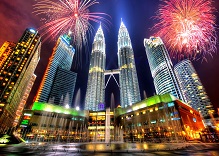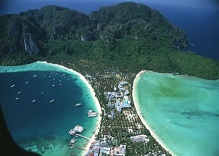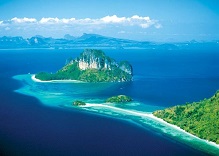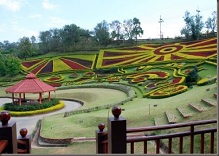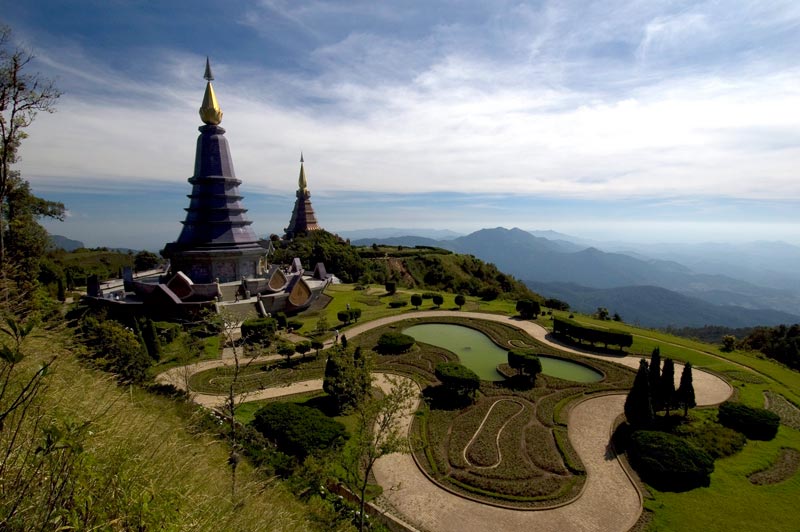To know Malaysia is to love Malaysia – a bubbling, bustling melting-pot of races and religions where Malays, Indians, Chinese and many other ethnic groups live together in peace and harmony. Our multiculturalism has made Malaysia a gastronomical paradise and home to hundreds of colourful festivals. It’s no wonder that we love celebrating and socialising. As a people, Malaysians are very relaxed, warm and friendly.
Geographically, Malaysia is almost as diverse as its culture. 11 states and 2 federal territories (Kuala Lumpur and Putrajaya) form Peninsular Malaysia which is separated by the South China Sea from East Malaysia which includes the 2 states (Sabah and Sarawak on the island of Borneo) and a third federal territory, the island of Labuan.
One of Malaysia’s key attractions is its extreme contrasts which further add to this theme of ‘diversity’. Towering skyscrapers look down upon wooden houses built on stilts while five-star HOTELS sit just metres away from ancient reefs.
Rugged mountains reach dramatically for the sky while their rainforest-clad slopes sweep down to floodplains teeming with forest life. Cool highland hideaways roll down to warm, sandy beaches and rich, humid mangroves.
For the perfect holiday full of surprises, the time is now, the place is Malaysia.
1.Sipadan Island
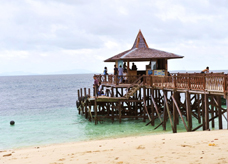 Malaysia’s sole oceanic island is very small in size. A 25-minute walk is all that is needed to circle the island on foot, but the huge amount of diverse marine life it attracts from the blackness of the open sea is simply mindblowing. Surrounded by crystal clear waters, this crown jewel is a treasure trove of some of the most amazing species out there. The jump-off point to Sipadan Island is Kota Kinabalu or Tawau. Thereafter, continue the journey with a 1-hour drive to Semporna town. A 30- minute speedboat will take you to Mabul, which is the jump- off point for Sipadan Island explorations.
Malaysia’s sole oceanic island is very small in size. A 25-minute walk is all that is needed to circle the island on foot, but the huge amount of diverse marine life it attracts from the blackness of the open sea is simply mindblowing. Surrounded by crystal clear waters, this crown jewel is a treasure trove of some of the most amazing species out there. The jump-off point to Sipadan Island is Kota Kinabalu or Tawau. Thereafter, continue the journey with a 1-hour drive to Semporna town. A 30- minute speedboat will take you to Mabul, which is the jump- off point for Sipadan Island explorations.
2.Langkawi Island
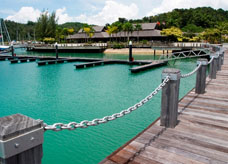 Despite what looks like a slant towards tourism, many of the islanders are actually farmers, fishermen and entrepreneurs. Experience the beautiful countryside and peaceful landscape of paddy fields by RENTING A CAR and taking a leisurely drive around the island. Some of Langkawi’s most rustic and memorable views are along the road that circles the island. You’ll pass small villages with wooden houses framed by palm trees, and children pedalling their old bicycles on errands. Aside from experiencing the local lifestyle, there is no shortage of things to do in Langkawi. Head up the thrilling new cable car to the summit of Mount Mat Cincang – Langkawi’s second highest mountain – for an unrivalled view of the entire main island and beyond. Other popular destinations are the Field of Burnt Rice, Hot Springs, Telaga Tujuh (The Seven Wells) and the Beach of Black Sand. Boat tours are organised to Tasik Dayang Bunting (Lake of the Pregnant Maiden), Gua Cerita (Cave of Stories) and Gua Langsir (Curtain Cave).
Despite what looks like a slant towards tourism, many of the islanders are actually farmers, fishermen and entrepreneurs. Experience the beautiful countryside and peaceful landscape of paddy fields by RENTING A CAR and taking a leisurely drive around the island. Some of Langkawi’s most rustic and memorable views are along the road that circles the island. You’ll pass small villages with wooden houses framed by palm trees, and children pedalling their old bicycles on errands. Aside from experiencing the local lifestyle, there is no shortage of things to do in Langkawi. Head up the thrilling new cable car to the summit of Mount Mat Cincang – Langkawi’s second highest mountain – for an unrivalled view of the entire main island and beyond. Other popular destinations are the Field of Burnt Rice, Hot Springs, Telaga Tujuh (The Seven Wells) and the Beach of Black Sand. Boat tours are organised to Tasik Dayang Bunting (Lake of the Pregnant Maiden), Gua Cerita (Cave of Stories) and Gua Langsir (Curtain Cave).
3.Pulau Redang
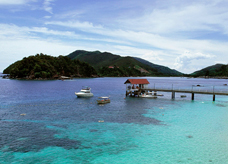 Pulau Redang, located 45km off the coast of Kuala Terengganu, is the largest of a group of nine protected islands dotting the South China Sea off the Terengganu coast. The island offers crystal clear waters and numerous dive sites for enthusiasts. Sheltered within the Pulau Redang Marine Park, the waters here are rich in marine life. At midday when sun rays penetrate the sea, brilliant hues of coral, anemones and fish can be seen.
Pulau Redang, located 45km off the coast of Kuala Terengganu, is the largest of a group of nine protected islands dotting the South China Sea off the Terengganu coast. The island offers crystal clear waters and numerous dive sites for enthusiasts. Sheltered within the Pulau Redang Marine Park, the waters here are rich in marine life. At midday when sun rays penetrate the sea, brilliant hues of coral, anemones and fish can be seen.
4.Pulau Perhentian
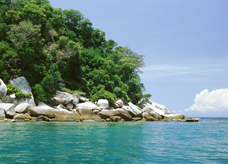 Pulau Perhentian, meaning ‘stopover island’, is not to be missed. Situated 21km off the coast of Terengganu, it consists of the islands of Pulau Perhentian Besar and Pulau Perhentian Kecil. Covered by unspoilt jungle, windswept palms, powdery white beaches and surrounded by sapphire blue waters, Pulau Perhentian is a sanctuary for fishermen, migratory birds and of course, discerning holiday- makers. Located just off the edge of the Pulau Redang Marine Park, Perhentian’s coral-fringed waters have excellent underwater seascapes for snorkelling and scuba diving.
Pulau Perhentian, meaning ‘stopover island’, is not to be missed. Situated 21km off the coast of Terengganu, it consists of the islands of Pulau Perhentian Besar and Pulau Perhentian Kecil. Covered by unspoilt jungle, windswept palms, powdery white beaches and surrounded by sapphire blue waters, Pulau Perhentian is a sanctuary for fishermen, migratory birds and of course, discerning holiday- makers. Located just off the edge of the Pulau Redang Marine Park, Perhentian’s coral-fringed waters have excellent underwater seascapes for snorkelling and scuba diving.
Arrangements can also be made for island cruises, and boats can be hired to go exploring for private bays and secluded coves. A trip to these tropical islands is also a must for those who enjoy windsurfing, sailing, canoeing and deep-sea fishing.
4.Tioman Island
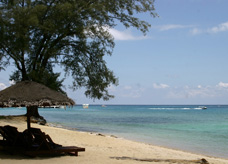 Discover astounding sights such as colourful Gorgonian sea fans, Staghorn corals, nudibranchs and beautifully sculptured sea sponges. Snorkellers can delight in swimming alongside huge Napoleon Wrasse, Golden Striped Trevally, Bumphead Parrotfish and shoals of Fusiliers. This island is an idyllic spot for leisurely days under the sun. Swim in its emerald waters, enjoy a stroll by the beach or be lulled to sleep by the sound of the waves. There are several villages scattered around the coastline, the larger ones being Salang, Tekek, Genting, Paya and Juara.
Discover astounding sights such as colourful Gorgonian sea fans, Staghorn corals, nudibranchs and beautifully sculptured sea sponges. Snorkellers can delight in swimming alongside huge Napoleon Wrasse, Golden Striped Trevally, Bumphead Parrotfish and shoals of Fusiliers. This island is an idyllic spot for leisurely days under the sun. Swim in its emerald waters, enjoy a stroll by the beach or be lulled to sleep by the sound of the waves. There are several villages scattered around the coastline, the larger ones being Salang, Tekek, Genting, Paya and Juara.
5.Kota Iskandar Johor
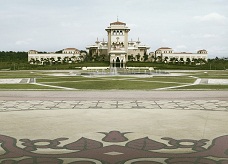 Kota Iskandar, Johor State Administrative Centre was opened in April 2009 and is now one of the must see places in Johor. Inspired by Moorish-Andalusian and Johor Malay designs and motifs, Kota Iskandar is Malaysia’s first Experiential Parliament where visitors through our guided tours will be allowed the chance to enter Johor’s beautiful state parliament hall and immersed in Johor’s rich culture and history while understanding the symbolisms and abstract interpretations in true style and splendour of Kota Iskandar- Johor’s Living Legacy.
Kota Iskandar, Johor State Administrative Centre was opened in April 2009 and is now one of the must see places in Johor. Inspired by Moorish-Andalusian and Johor Malay designs and motifs, Kota Iskandar is Malaysia’s first Experiential Parliament where visitors through our guided tours will be allowed the chance to enter Johor’s beautiful state parliament hall and immersed in Johor’s rich culture and history while understanding the symbolisms and abstract interpretations in true style and splendour of Kota Iskandar- Johor’s Living Legacy.
6.Petrosains ‘The Discovery Centre’
 Petrosains is a Science Discovery Centre that uses a fun and interactive approach to tell the story of the science and technology of the petroleum industry. Its concept and contents revolve specifically around the science of petroleum, yet embrace all the general sciences. The hands-on approach adopted by Petrosains puts an emphasis on the fun and excitement of learning rather than on the rigorous memorisation of scientific facts.
Petrosains is a Science Discovery Centre that uses a fun and interactive approach to tell the story of the science and technology of the petroleum industry. Its concept and contents revolve specifically around the science of petroleum, yet embrace all the general sciences. The hands-on approach adopted by Petrosains puts an emphasis on the fun and excitement of learning rather than on the rigorous memorisation of scientific facts.
7.Genting Highlands
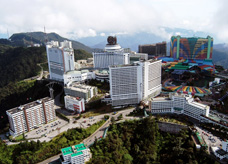 The fun never stops at Genting, City of Entertainment, perched on the top of cool, breezy Genting Highlands. One big attraction in Genting is the cool weather. Because of the 2,000m altitude, Malaysians like to visit just to enjoy the ‘European’ weather! In the evening, there is spectacular entertainment at the Genting International Showroom or Pavilion, be it a thrilling magic show or an ice-skating extravaganza. There are also opportunities to go shopping at First World Plaza, visit the indoor and outdoor theme parks and feast on a wide range of delicious food at the many restaurants.
The fun never stops at Genting, City of Entertainment, perched on the top of cool, breezy Genting Highlands. One big attraction in Genting is the cool weather. Because of the 2,000m altitude, Malaysians like to visit just to enjoy the ‘European’ weather! In the evening, there is spectacular entertainment at the Genting International Showroom or Pavilion, be it a thrilling magic show or an ice-skating extravaganza. There are also opportunities to go shopping at First World Plaza, visit the indoor and outdoor theme parks and feast on a wide range of delicious food at the many restaurants.
8.Petronas Twin Towers
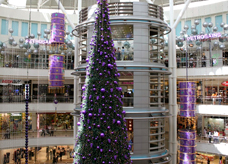 Soaring to a height of 451.9 metres, the 88-storey twin structure is Kuala Lumpur’s crown jewel. Majestic by day and dazzling at night, the PETRONAS Twin Towers is inspired by Tun Mahathir Mohamad’s vision for Malaysia to be a global player. Together with master architect Cesar Pelli, the international icon powerfully captures the nation’s ambitions and aspirations. Visit us and experience the PETRONAS Twin Towers first-hand. Begin your tour with interactive displays that showcase the journey, from idea to completion. Scale 170 metres in an elevator with a futuristic edge. The doors will open at the Skybridge, a connecting structure between the towers and the world’s highest 2-storey bridge. Ascend even higher to level 86, where the story of Malaysia’s vision unfolds amid breathtaking views of Kuala Lumpur. Then wrap up your visit with exquisite souvenirs at the gift shop.
Soaring to a height of 451.9 metres, the 88-storey twin structure is Kuala Lumpur’s crown jewel. Majestic by day and dazzling at night, the PETRONAS Twin Towers is inspired by Tun Mahathir Mohamad’s vision for Malaysia to be a global player. Together with master architect Cesar Pelli, the international icon powerfully captures the nation’s ambitions and aspirations. Visit us and experience the PETRONAS Twin Towers first-hand. Begin your tour with interactive displays that showcase the journey, from idea to completion. Scale 170 metres in an elevator with a futuristic edge. The doors will open at the Skybridge, a connecting structure between the towers and the world’s highest 2-storey bridge. Ascend even higher to level 86, where the story of Malaysia’s vision unfolds amid breathtaking views of Kuala Lumpur. Then wrap up your visit with exquisite souvenirs at the gift shop.
9.Legoland
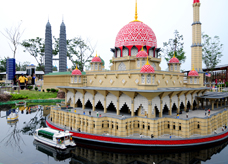 Legoland Malaysia theme park, the first in Asia, is situated in Nusajaya, Johor. Situated on 76 acres of land, the park is the sixth such park to open in the world. Previous parks are located in Billund, Denmark (1968), Windsor, England (1996), California, USA (1999), Germany (2002), Florida, USA (2005). Legoland is built with over 40 interactive rides, shows and attractions. One of the main attractions here is the Miniland. More than 30 million lego bricks are used in the building of these monuments including the Petronas Twin Towers, The Merlion Statue, Taj Mahal and others.
Legoland Malaysia theme park, the first in Asia, is situated in Nusajaya, Johor. Situated on 76 acres of land, the park is the sixth such park to open in the world. Previous parks are located in Billund, Denmark (1968), Windsor, England (1996), California, USA (1999), Germany (2002), Florida, USA (2005). Legoland is built with over 40 interactive rides, shows and attractions. One of the main attractions here is the Miniland. More than 30 million lego bricks are used in the building of these monuments including the Petronas Twin Towers, The Merlion Statue, Taj Mahal and others.
10.Gunung Mulu National Park
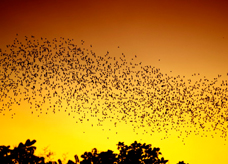 Mulu Caves National Park is home to one of the longest networks of caves in the world. Here lies the worlds largest underground chamber, the Sarawak Chamber, capable of ACCOMMODATINGforty Boeing 747 airplanes. In Mulu, you will also find one of the worlds biggest cave passage, Deer Cave, which can fit five cathedrals the size of Saint Pauls in London. Another key attraction is Clear Water Cave, the longest cave in Southeast Asia. The massive caves here are home to millions of bats and cave swiftlets that swarm out into the jungle in great clouds every evening at dusk!
Mulu Caves National Park is home to one of the longest networks of caves in the world. Here lies the worlds largest underground chamber, the Sarawak Chamber, capable of ACCOMMODATINGforty Boeing 747 airplanes. In Mulu, you will also find one of the worlds biggest cave passage, Deer Cave, which can fit five cathedrals the size of Saint Pauls in London. Another key attraction is Clear Water Cave, the longest cave in Southeast Asia. The massive caves here are home to millions of bats and cave swiftlets that swarm out into the jungle in great clouds every evening at dusk!
11.Batu Caves
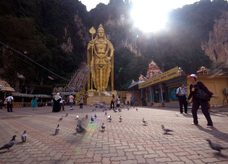 Batu Caves is a an iconic and popular tourist attraction in Selangor. Site of a Hindu temple and shrine, Batu Caves attracts thousands of worshippers and tourists, especially during the annual Hindu festival, Thaipusam. A limestone outcrop located just north of Kuala Lumpur, Batu Caves has three main caves featuring temples and Hindu shrines.
Batu Caves is a an iconic and popular tourist attraction in Selangor. Site of a Hindu temple and shrine, Batu Caves attracts thousands of worshippers and tourists, especially during the annual Hindu festival, Thaipusam. A limestone outcrop located just north of Kuala Lumpur, Batu Caves has three main caves featuring temples and Hindu shrines.
Its main attraction is the large statue of the Hindu God at the entrance, besides a steep 272 climb up its steps to finally view the stunning skyline of the city centre. Monkeys frolic around the caves, and it is a popular spot for rock climbing enthusiasts. Paintings and scenes of Hindu Gods can also be seen in the Ramayana Cave.
12.Cameron Highlands
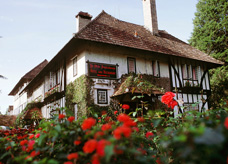 There are many things to see and do in Cameron Highlands, Malaysia’s largest highland resort. Walks through lovely little villages, visits to the butterfly, strawberry, honey bee farms and sprawling tea plantations or meals at the delightful Tudor-styled country inns, are all pleasurable and relaxing activities to be experienced here. You can’t beat the weather up here. A few days out of the sweltering lowland heat will surely recharge your batteries. One other popular activity in Cameron Highlands, actually more of a tradition, is to have tea and scones. This very English tradition dates back to the days when English colonial officers used this hilly location as a cool getaway from the heat of the lowlands. Bird-watching and trekking are also popular activities here.
There are many things to see and do in Cameron Highlands, Malaysia’s largest highland resort. Walks through lovely little villages, visits to the butterfly, strawberry, honey bee farms and sprawling tea plantations or meals at the delightful Tudor-styled country inns, are all pleasurable and relaxing activities to be experienced here. You can’t beat the weather up here. A few days out of the sweltering lowland heat will surely recharge your batteries. One other popular activity in Cameron Highlands, actually more of a tradition, is to have tea and scones. This very English tradition dates back to the days when English colonial officers used this hilly location as a cool getaway from the heat of the lowlands. Bird-watching and trekking are also popular activities here.
13.KL Bird Park
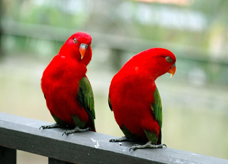 The KL Bird Park is located in the serene and scenic Perdana Botanical Gardens, 10 minutes away from the Kuala Lumpur city centre. Home to more than 3,000 birds of 200 local and foreign bird species, the main feature that distinguishes KL Bird Park from other bird parks is the concept of free-flight. Stroll through the park, and take the opportunity to see Mandarin ducks, hawk eagles, hornbills, ostriches and other birds. Visit the Egg Incubation Room and Nursery and see how chicken eggs are artificially incubated using incubators.
The KL Bird Park is located in the serene and scenic Perdana Botanical Gardens, 10 minutes away from the Kuala Lumpur city centre. Home to more than 3,000 birds of 200 local and foreign bird species, the main feature that distinguishes KL Bird Park from other bird parks is the concept of free-flight. Stroll through the park, and take the opportunity to see Mandarin ducks, hawk eagles, hornbills, ostriches and other birds. Visit the Egg Incubation Room and Nursery and see how chicken eggs are artificially incubated using incubators.
14.Langkawi Cable Car
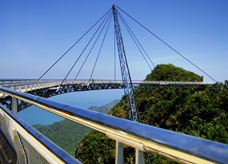 At 709 metres above sea level, the cable car ride up to Langkawi’s second highest peak is truly an experience not to be missed. Throughout the 20-minute ride, you will pass over jungle waterfalls and a thick carpet of virgin rainforest. On a clear day, you can see parts of Thailand towards the north and Indonesia towards the south-west.
At 709 metres above sea level, the cable car ride up to Langkawi’s second highest peak is truly an experience not to be missed. Throughout the 20-minute ride, you will pass over jungle waterfalls and a thick carpet of virgin rainforest. On a clear day, you can see parts of Thailand towards the north and Indonesia towards the south-west.
Travelling at a steep incline of 42 degrees, over a distance of 2.2 kilometres from the base station to the two mountain-top stations, even the gentlest breeze is enough to send one’s stomach churning. But once you get used to the sensation of being airborne, the ride quickly turns into an amazing, exhilarating experience. At the top, a sky bridge offers a breathtaking view of Langkawi. Remember to wear comfortable shoes as it is quite a walk up to the hanging bridge.
15.Kek Lok Si
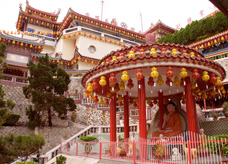 Located in Air Itam, the hills in that area (called “He San” or Crane Hill) have traditionally been regarded as geomantically significant, having all the right “feng shui” for a temple. In fact, they are extremely popular as a retreat for monks and Taoists striving for immortality. The temple’s construction began in 1893, inspired by the chief monk of the Goddess of Mercy Temple at Pitt Street. The Manchu Emperor Guangxu approved of the project, bestowing a tablet and gift of 70,000 volumes of the Imperial Edition of the Buddhist Sutras. Other Chinese rulers, such as His Majesty Emperor Kuang Xi and Empress Cixi of the Ching Dynasty, have been sufficiently impressed with the temple so as to have bestowed the temple with gifts.
Located in Air Itam, the hills in that area (called “He San” or Crane Hill) have traditionally been regarded as geomantically significant, having all the right “feng shui” for a temple. In fact, they are extremely popular as a retreat for monks and Taoists striving for immortality. The temple’s construction began in 1893, inspired by the chief monk of the Goddess of Mercy Temple at Pitt Street. The Manchu Emperor Guangxu approved of the project, bestowing a tablet and gift of 70,000 volumes of the Imperial Edition of the Buddhist Sutras. Other Chinese rulers, such as His Majesty Emperor Kuang Xi and Empress Cixi of the Ching Dynasty, have been sufficiently impressed with the temple so as to have bestowed the temple with gifts.
16.Putra Mosque
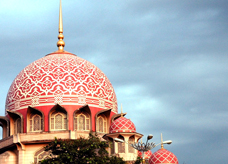 The mosque consists of three main functional areas – the prayer hall, the Sahn, or courtyard, and various learning facilities and function rooms. The prayer hall is simple and elegant, supported by 12 columns. The highest point below the dome is 250 feet above ground level. The Sahn, landscaped with several decorative water features and bordered by colonnades, provides a huge yet welcoming and beautiful prayer space. Its impressive minaret is influenced by the design of the Sheikh Omar Mosque in Baghdad. At 116m, it is one of the tallest minarets in the region and has five tiers, representing the Five Pillars of Islam.
The mosque consists of three main functional areas – the prayer hall, the Sahn, or courtyard, and various learning facilities and function rooms. The prayer hall is simple and elegant, supported by 12 columns. The highest point below the dome is 250 feet above ground level. The Sahn, landscaped with several decorative water features and bordered by colonnades, provides a huge yet welcoming and beautiful prayer space. Its impressive minaret is influenced by the design of the Sheikh Omar Mosque in Baghdad. At 116m, it is one of the tallest minarets in the region and has five tiers, representing the Five Pillars of Islam.
17.Sultan Abdul Samad Building
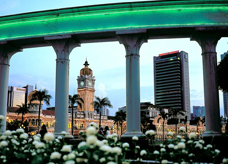 The iconic Sultan Abdul Samad building is located in front of Dataran Merdeka and Royal Selangor Club, along Jalan Tunku Abdul Rahman. It was completed in 1897 by A.C. Norman. During the time of the British administration in Malaya, it was used to house several government departments. Today, this historical building houses the Supreme and High Courts. The building with unique Moorish designs and clock tower is widely photographed by visitors to the city centre.
The iconic Sultan Abdul Samad building is located in front of Dataran Merdeka and Royal Selangor Club, along Jalan Tunku Abdul Rahman. It was completed in 1897 by A.C. Norman. During the time of the British administration in Malaya, it was used to house several government departments. Today, this historical building houses the Supreme and High Courts. The building with unique Moorish designs and clock tower is widely photographed by visitors to the city centre.
Krabi Province, which lies along the coast of the Andaman sea in Southern Thailand, is a top tourist destination as a result of its plentiful natural attractions including, white sandy beaches, crystal clear water, extensive coral reefs, numerous caves and waterfalls, and over 130 islands, including Koh Lanta and the jewels of the Andaman coast, the six islands of Mu Koh Phi Phi National Park. While not the top destination in and of itself, Krabi Town is a charming provincial capital located along the banks of a river that leads to the nearby Andaman Sea. Consequently, Krabi is an important port city for both local fisherman as well as boats ferrying visitors to the nearby attractions, including Koh Phi Phi, Koh Lanta, and Railey Beach, one of the premier rock climbing destinations in the world.
1.Sea Kayak Krabi
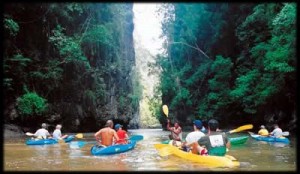 Sea Kayak Krabi Tours provide the eco-experience of a lifetime where you’ll explore the wonders of sea caves, wild tropical mangrove forests and the thrilling karst limestone formations of Phang Nga bay.
Sea Kayak Krabi Tours provide the eco-experience of a lifetime where you’ll explore the wonders of sea caves, wild tropical mangrove forests and the thrilling karst limestone formations of Phang Nga bay.
The north part of Krabi Province boasts dramatic karst topography and an abundance of caves.
The first cave you will visit is Tham Lod, which has a spectacular tunnel through the karst that is richly adorned with stalactites and stalagmites. The entrance to the passage is overhung by a curtain of jungle vines.
The limestone cliffs surrounding the cave are richly adorned with endemic palms and cycads. Continuing from Tham Lod it is just a few minutes’ paddle to the Big Headed Ghost Cave, known as Tham Pee Hua Toe, where a human skull was found that was much larger than normal size, hence the name.
2.Railay Beach
 Located just south of the coastal town of Ao Nang in the Krabi Province, Railay Beach, also known as Rai Lay or Ray Leh, is a small peninsula surrounded by tall limestone cliffs and known for being one of the finest beaches in the region.
Located just south of the coastal town of Ao Nang in the Krabi Province, Railay Beach, also known as Rai Lay or Ray Leh, is a small peninsula surrounded by tall limestone cliffs and known for being one of the finest beaches in the region.
Its isolated location from the mainland ensures complete privacy. There is no noise from cars or the beeping of tuk tuk horns, just peace and quiet; the way paradise should be. It actually makes Railay Beach feel like an island getaway, which is very rare on the mainland.
Attracting thousands of visitors each year, the beach is somewhat iconic and might not posess the same beauty it had 20 years ago, due to the vast amount of visitors it receives, it’s still one of the finest beaches on the mainland in Southern Thailand, which is quite an accolade in itself.
The Limestone cliffs are highly desirable for rock climbing, with Krabi Province being exceptionally famous across the world in rock climbing circles.
3.Ao Nang Beaches
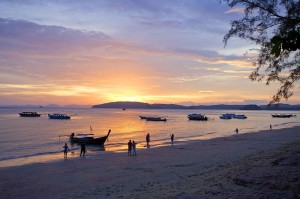 Ao Nang is Krabi’s vibrant tourist centre. It has the relaxed atmosphere of a small town, the beauty of a beach resort, and the unique friendliness that sets Thailand apart from the rest.
Ao Nang is Krabi’s vibrant tourist centre. It has the relaxed atmosphere of a small town, the beauty of a beach resort, and the unique friendliness that sets Thailand apart from the rest.
This part of the world is famed for one thing and one thing only: its jaw-dropping natural beauty. The golden beaches and towering limestone cliffs are good enough reason alone for the hordes of backpackers to make the epic journey south from Bangkok. While those who aren’t on a shoestring budget usually fly in, the brave soles making the overland journey can expect to spend around 13 hours on the bus or a whopping 20 hours on the train. And it’s worth it.
4.Ao Nang Beaches
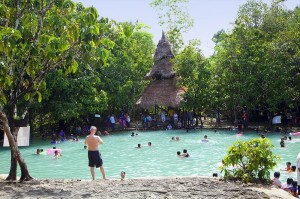 The pool is situated in the Krabi District’s Klong Thom District. It is quite easy to find as there are plenty of signboards near the area announcing its presence. There are two trails leading to the pool and both are quite scenic. While the waters are extremely clear and plenty of fun to swim in, they are not potable due to extremely high calcium carbonate levels.
The pool is situated in the Krabi District’s Klong Thom District. It is quite easy to find as there are plenty of signboards near the area announcing its presence. There are two trails leading to the pool and both are quite scenic. While the waters are extremely clear and plenty of fun to swim in, they are not potable due to extremely high calcium carbonate levels.
The compound can also be found as white deposits around the pool, especially during the summer. The colour of the water is caused by a combination of algae and bacteria. Visitors are advised not to use chemicals such as soap and shampoo at the Emerald Pool as they can destroy the algae. Tourists in Krabi should definitely try to visit this place.
The dive sites surrounding Ko Lanta are considered to be some of Thailand’s finest. An intricate system of reefs, islets, and underwater caves are teeming with vibrant sea life. While you splash in the waves you may catch a glimpse of a Moken (sea gypsy) boat, gliding nomadically through the waters. Cap off your day with mouthwatering seafood, freshly caught and spicy enough to make your tongue tingle.
1. Mu Koh Lanta Park and Koh Lanta Lighthouse
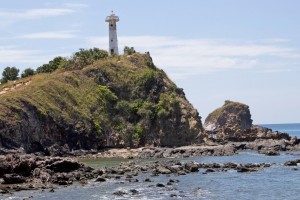 For many years, Koh Lanta was known as the “natural” alternative to the willy-nilly development seen throughout Southern Thailand’s island paradise. Lanta learned from the mistakes of nearby islands, and today still has the laidback, no-shoes-for-a-week style that first attracted visitors to Thailand.
For many years, Koh Lanta was known as the “natural” alternative to the willy-nilly development seen throughout Southern Thailand’s island paradise. Lanta learned from the mistakes of nearby islands, and today still has the laidback, no-shoes-for-a-week style that first attracted visitors to Thailand.
Now, though, it’s also possible to find something to eat after 7pm, and the famous red dirt road has (mostly) been paved, all the while retaining its stunning natural beauty. That’s “development” that many people can agree with.
Mu Koh Lanta National Park is the ultimate sanctuary and time capsule. Here, you can experience the Thailand that attracted tourists and adventurers decades before.
2. Koh Lanta Old Town
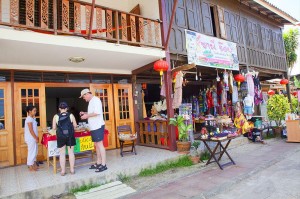 Step back in time with a trip to the small forgotten community of Old Town Koh Lanta, located just off the Andaman Coast of Southern Thailand. With a combination of wonderfully rich and diverse cultures including the Chao Leh or Sea Gypsies, Chinese traders and a large Muslim community in this region has been shaped into one of the more unique tourist spots you could hope for as well with some of Thailand’s best seafood!
Step back in time with a trip to the small forgotten community of Old Town Koh Lanta, located just off the Andaman Coast of Southern Thailand. With a combination of wonderfully rich and diverse cultures including the Chao Leh or Sea Gypsies, Chinese traders and a large Muslim community in this region has been shaped into one of the more unique tourist spots you could hope for as well with some of Thailand’s best seafood!
In a word, Koh Lanta Old Town is about simplicity, with just about everything you need within walking distance and with almost every house along the main street offering one-of-a-kind souvenirs and gifts. You’re sure to go home with something original.
3. Koh Rok
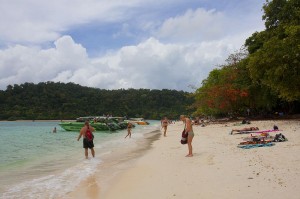 As a rule, the extremely wealthy are usually the only ones able to enjoy a solitary stroll along white sand beachfront properties or lounge lazily in crystal clear waters warm enough to fall asleep in without the worry of running into hoards of tourists, but that’s all about to change. With only 100 meters between them, 30km south of Koh Lanta Yai, you will find Ko Rok Nok and Ko Rok Nai. These heavenly destinations are unquestionably the most remote and unspoiled of all the Andaman Islands. Relax knowing that you’re among only a handful of humans within the interior or exterior of either of these lush rainforest paradises.There are almost no human beings whatsoever living on KohRok. Only the Marine Park Rangers reside here, leaving the islands unspoiled.
As a rule, the extremely wealthy are usually the only ones able to enjoy a solitary stroll along white sand beachfront properties or lounge lazily in crystal clear waters warm enough to fall asleep in without the worry of running into hoards of tourists, but that’s all about to change. With only 100 meters between them, 30km south of Koh Lanta Yai, you will find Ko Rok Nok and Ko Rok Nai. These heavenly destinations are unquestionably the most remote and unspoiled of all the Andaman Islands. Relax knowing that you’re among only a handful of humans within the interior or exterior of either of these lush rainforest paradises.There are almost no human beings whatsoever living on KohRok. Only the Marine Park Rangers reside here, leaving the islands unspoiled.
4. Kayak Trip at Koh lanta
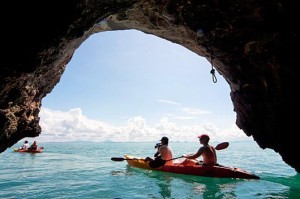 Kayaking is one of the many attractions on the Koh Lanta islands of Southern Thailand. Although not quite as spectacular as the sea kayaking around neighboring Krabi province, it’s one of the best ways to take in the natural beauty of KohLanta.
Kayaking is one of the many attractions on the Koh Lanta islands of Southern Thailand. Although not quite as spectacular as the sea kayaking around neighboring Krabi province, it’s one of the best ways to take in the natural beauty of KohLanta.
Most of the island’s beaches have at least one kayak rental shop that usually charges by the hour. It’s not necessary to hire a guide, and visitors can explore by themselves, along the coast or across the water to one of the tiny deserted islets. KohLanta’s east side is more rocky, with mysterious limestone caves, secret coves and clear emerald water. Completely uncrowded, the best way to see this part of the island is to take your time exploring by kayak.
5. Lanta Beach
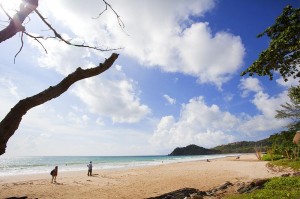 Koh Lanta is a string of beautiful islands off the Andaman Coast in Southern Thailand. The landscapes, smells, sounds and sights are all unique to this local area. From the open beaches to the more remotely accessed ports, the Koh Lanta islands provide an escape from the crowded surfs of the more commercial shores of Southern Thailand yet offer every amenity the wayward traveler might desire. Holidays are meant for excess so if you’re in the mood for a bit of the bustle you can always head to either of Koh Lanta’s two larger islands, Ko Lanta Noi or Ko Lanta Yai, where those looking for a nightcap to end a perfect day can find their favorite beverage always on hand.
Koh Lanta is a string of beautiful islands off the Andaman Coast in Southern Thailand. The landscapes, smells, sounds and sights are all unique to this local area. From the open beaches to the more remotely accessed ports, the Koh Lanta islands provide an escape from the crowded surfs of the more commercial shores of Southern Thailand yet offer every amenity the wayward traveler might desire. Holidays are meant for excess so if you’re in the mood for a bit of the bustle you can always head to either of Koh Lanta’s two larger islands, Ko Lanta Noi or Ko Lanta Yai, where those looking for a nightcap to end a perfect day can find their favorite beverage always on hand.
The quieter neighbor of Chiang Mai, Chiang Rai is a land of outstanding natural beauty, where visitors looking to avoid the hordes can visit remote hill tribes, spot exotic wildlife, and check out the golden triangle, the former center of the world’s opium trade. Chiang Rai is a traveler’s paradise, endowed with abundant natural attractions and antiquities. Attractions range from ruins of ancient settlements and Buddhist shrines to magnificent mountain scenery and hill tribe villages. For those interested in the natural side of Chiang Rai, jungle trekking is a magical experience; explore the mountains of the north along various hiking trails, many of which access the villages of diverse hill tribes groups, many of whom maintain their traditional lifestyles. Chiang Rai town, which tends to be a little more ‘laid back’ than its more popular neighbor, now competes with Chiang Mai as a tourist attraction and is fast becoming a popular escape for tourists wanting to leave their troubles behind.
1. Chiang Rai One Day Trip
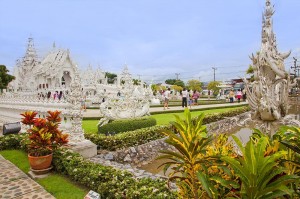 Rong Khun Temple
Rong Khun Temple
Wat Rong Khun is also known as the White Temple. Whereas most temples visited by tourists have a history going back many centuries, this magnificent place of worship was built only recently. It is the realization of a dream for Thailand’s noted artist, Mr Chalermchai Kositpipat, who designed and supervised the construction of this beautiful white temple and its many statues of figures.
Karen Ruammit Elephant Club
Enjoy some elephant trekking at the Karen Ruammit Elephant Club. The Karen village of Ruammit, on the banks of Nam Mae Kok (Mae Kok River), is promoted as a Karen community, but nearby are Lahu, Lisu and Akha villages clustered on its outskirts. Despite its equally mountainous location, it is quite different to adjacent towns of Baan Thaton and Doi Mae Salong. If you want to see the picturesque Chiang Rai jungle at first hand, this elephant trekking park is one of the best in the region.
Mae Sai Waterfall
Huai Mae Sai Waterfall is a part of Mae Kok National Park that, located in Huai Mae Sai village, Mae Yao Sub-District,19km away from the city of Chiang Rai. Huai Mae Sai waterfall is set over 2 levels. The first level is 15m-high. The 1st level is covered with moss and fern. The 2nd level has a pond where tourists can swim.
King Mengrai Monument
The King Mengrai Great Memorial is located in the town on the intersection leading to Mae Chan. Originally, King Mengrai was the ruler of Nakhon Hiran Ngoen Yang, an ancient town on the banks of the Mae Khong around Chiang Saen, before Chiang Rai was established as the administrative center in 1262. He consolidated his power by merging the city in the north and founded the Lanna Thai Kingdom in 1296 with Chiang Mai as the capital.
Chiang Rai Night Bazaar
A fraction of the size of Chiang Mai’s more famous night bazaar, the mini version in downtown Chiang Rai is still a pleasant place for an evening stroll and an excellent option for snacks and a beer. The offerings are similar, though much reduced in choice, to the Chiang Mai version: hill-tribe handicrafts, pirated DVDs, T-shirts, carved soap candles and so on.
2. Chiang Rai One Day Trip
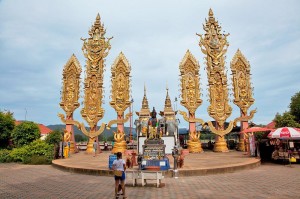 Every guidebook seems to have a different view of the evolution of the term ‘golden triangle’ and even disagree on when the term was coined. Most do agree that the term applies to the opium growing region covering Northern Thailand, Eastern Burma and Western Laos. Many tourists flock to the Golden Triangle region of Thailand expecting some sort of ‘wild west’ scene. They are certainly disappointed. The Thai area of the former triangle is full of small quiet villages where the most exciting thing that happens is the arrival of the next tour bus.
Every guidebook seems to have a different view of the evolution of the term ‘golden triangle’ and even disagree on when the term was coined. Most do agree that the term applies to the opium growing region covering Northern Thailand, Eastern Burma and Western Laos. Many tourists flock to the Golden Triangle region of Thailand expecting some sort of ‘wild west’ scene. They are certainly disappointed. The Thai area of the former triangle is full of small quiet villages where the most exciting thing that happens is the arrival of the next tour bus.
The area is full of beautiful natural scenery and ancient temples, so it’s very much worth a visit. Just go with the proper expectations. In fact, the area is proving quite popular for those that want something different, away from the beach scene. To serve them, a number of hotels and resorts have been built in the area, some of them quite luxurious.
3. Doi Tung Mountain in Chiang Rai
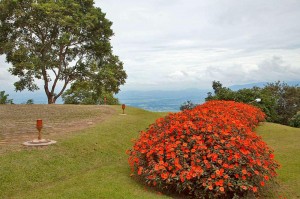 Known by locals as Thailand’s Switzerland, Doi Tung, otherwise known as Flag Mountain, is an attractive mountain-top destination of forests and nearby Shan, Akha and Lahu tribal villages. Probably the most important attraction in the area is Wat Phrathat Doi Tung – a temple built 1,000-years ago which is an important place of pilgrimage for Buddhists from Thailand and overseas.
Known by locals as Thailand’s Switzerland, Doi Tung, otherwise known as Flag Mountain, is an attractive mountain-top destination of forests and nearby Shan, Akha and Lahu tribal villages. Probably the most important attraction in the area is Wat Phrathat Doi Tung – a temple built 1,000-years ago which is an important place of pilgrimage for Buddhists from Thailand and overseas.
A giant flag was flown from the point where the temple’s chedis were built giving ‘flag mountain’ its name. Doi Tung is also home to the Doi Tung Development Project, an initiative of Her Royal Highness Srinakarindra, who passed away in 1995.
Now famous for its flowers, trees and clear mountain air, Doi Tung has traditionally been an area at the center of Thailand’s opium production, and with a ready supply of the drug in the area, drug use was prevalent, especially amongst the poor.
Chiang Mai has its own very distinctive culture, arts, festivals, and traditions as well as an exciting mix of local, ethnic as well as expatriate communities from all over the world. It has been voted one of the top destinations to live in Asia and is a modern and cosmopolitan city, while not having lost its traditional old charm. more..
1. Chiang Mai Walking Street
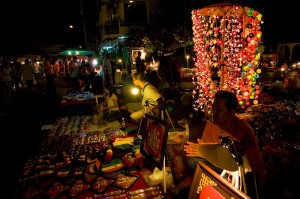 Unlike in the Night Market, there’s hardly anything resembling designer rip-offs, although the fake Rolexes as popularised by Madonna make an occasional appearance. The street is home to a number of temples, all of which turn into outdoor food courts for the night, giving a plethora of opportunities to try authentic Lanna foods at incredibly low prices. This pedestrianised walking street attracts Thais as well as tourists and is growing larger by year due to its popularity, street musicians, traditional puppeteers and huge numbers of goods on show at the stalls. Rachadamnoen Street is lined with coffee shops and bars, with people-watching a favourite occupation. Thai dancing shows are often performed in the tiny squares and temple grounds. Arriving before it gets dark gives the chance of a visit to Wat Chedi Luang, set half-way down the street, once home in the 15th century to Thailand’s famed Jade Buddha and still home to the ancient Pillar of the City legendarily charged with keeping the town safe from invaders.
Unlike in the Night Market, there’s hardly anything resembling designer rip-offs, although the fake Rolexes as popularised by Madonna make an occasional appearance. The street is home to a number of temples, all of which turn into outdoor food courts for the night, giving a plethora of opportunities to try authentic Lanna foods at incredibly low prices. This pedestrianised walking street attracts Thais as well as tourists and is growing larger by year due to its popularity, street musicians, traditional puppeteers and huge numbers of goods on show at the stalls. Rachadamnoen Street is lined with coffee shops and bars, with people-watching a favourite occupation. Thai dancing shows are often performed in the tiny squares and temple grounds. Arriving before it gets dark gives the chance of a visit to Wat Chedi Luang, set half-way down the street, once home in the 15th century to Thailand’s famed Jade Buddha and still home to the ancient Pillar of the City legendarily charged with keeping the town safe from invaders.
2. Chiang Mai Temples
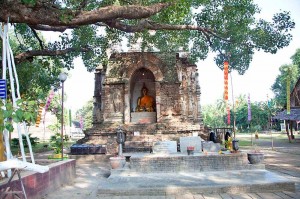 Wat Chiang Mun
Wat Chiang Mun
Wat Chiang Mun is situated within the city walls on Rajpakinai Road on the north side of Chiang Mai city. This temple is one of the most historically significant in Chiang Mai, due to it being the first Royal temple constructed within the city grounds in 1296 by King Mengrai. Although the temple has been restored in recent times, you can still see the old foundations and walls from that bygone period in time. At Wat Chiang Mun, you will find a tiny enshrined crystal Buddha named Pra Seh-Taang Kamaneeee.
Wat Phra Singh
Wat Phra Singh is translated as “The Temple of the Lion Buddha.” Constructed in 1345 by King Pha Yu to hold the ashes of his father, King Kham Fu, housing 2 medieval Buddhist images. The temple is one of the most important Buddhist monasteries in this part of the world. Believed to be the first monastery to hold the Emerald Buddha, which was then moved to Wat Chedi Luang and now rests in Bangkok at Wat Phra Kaew, this temple is extremely sacred. When visiting this Chiang Mai temple, you will more than likely be approached by one or more of the 700 monks who live here, so they can brush up on their English. They are very friendly.
3. Doi Suthep Temple
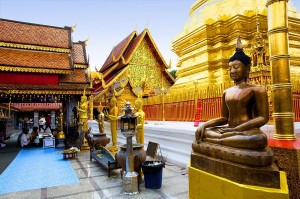 Doi Suthep with its famous temple and Royal Palace is Chiang Mai’s sacred mountain; a place of pilgrimage for tens of thousands of Buddhists on the high holy day of Visakha Bucha in early summer. It’s also a tourist magnet, both for the spectacular Wat Prathat Doi Suthep with its glorious golden chedi holding a relic of the Buddha and for the spectacular views over the city and Doi Suthep National Park. A comfortable walk or short songthaew ride away are lovely Bhuping Royal Palace Gardens.
Doi Suthep with its famous temple and Royal Palace is Chiang Mai’s sacred mountain; a place of pilgrimage for tens of thousands of Buddhists on the high holy day of Visakha Bucha in early summer. It’s also a tourist magnet, both for the spectacular Wat Prathat Doi Suthep with its glorious golden chedi holding a relic of the Buddha and for the spectacular views over the city and Doi Suthep National Park. A comfortable walk or short songthaew ride away are lovely Bhuping Royal Palace Gardens.
4. Muang On Cave in Chiang Mai
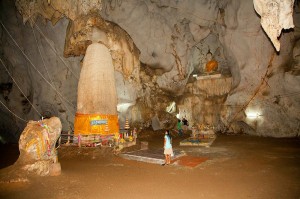 Located in Mae Sot just a short drive from San Kamphaeng Hot Springs and 30km from the northern city of Chiang Mai, the Muang On Cave is a place of legends, Buddhist and animistic traditions and spectacular natural formations.
Located in Mae Sot just a short drive from San Kamphaeng Hot Springs and 30km from the northern city of Chiang Mai, the Muang On Cave is a place of legends, Buddhist and animistic traditions and spectacular natural formations.
Little-known except to local people, it’s far less crowded than many of Chiang Mai’s other attractions and gives a rare glimpse into the unique culture of the former Lanna Kingdom.
5. Chiang Mai Sudaluck Wood Carving
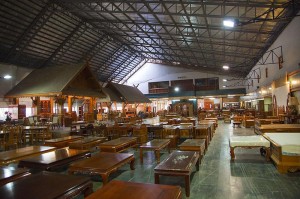 There is nothing better to decorate your house than with high quality and handmade arts and crafts. They add that special ambience to a property and in some cases provide that finishing touch. Chiang Mai Sudaluck is the finest establishment for hand-carved furniture and accessories in and around the city.
There is nothing better to decorate your house than with high quality and handmade arts and crafts. They add that special ambience to a property and in some cases provide that finishing touch. Chiang Mai Sudaluck is the finest establishment for hand-carved furniture and accessories in and around the city.
This traditional Thai company benefits from expertise handed down from generation to generation over the course of centuries, creating artistic masterpieces and furniture from teak and rose wood. Every single item is a unique work of art hand carved and meticulously designed to add a touch of class to your home.
The shop houses over 400 unique furniture products in stock which you can peruse at your own time and pace. Teak and Rosewood are two of the finest woods in the world for carving.
6. P Collection Silverware Manufactures
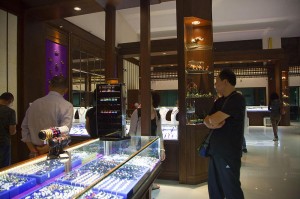 Visiting Chiang Mai and not basking in its vast arts and craft culture is like going to Rome and not visiting the Coliseum. The P.Collection factory specializes in manufacturing and exporting Sterling Silver products and gold and silver jewelry. This pristine production house is chicly designed with glass-encased treats at every turn. All the items are produced and developed in the factory shop positioned beside the showroom. This allows you the great opportunity of watching these highly skilled craftsmen at work polishing and engraving stones with a deft and delicate touch only an expert could muster.
Visiting Chiang Mai and not basking in its vast arts and craft culture is like going to Rome and not visiting the Coliseum. The P.Collection factory specializes in manufacturing and exporting Sterling Silver products and gold and silver jewelry. This pristine production house is chicly designed with glass-encased treats at every turn. All the items are produced and developed in the factory shop positioned beside the showroom. This allows you the great opportunity of watching these highly skilled craftsmen at work polishing and engraving stones with a deft and delicate touch only an expert could muster.
7. Doi Pui Hmong Village
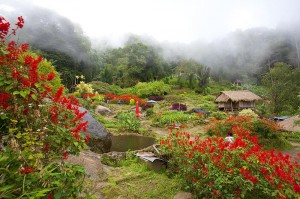 Doi Pui Village is home to members of the Hmong hill tribe, and is set on the far heights of Doi Suthep Mountain in Doi Suthep National Park. It’s a popular spot for tourist visits, but not all the villagers are involved in the Chiang Mai tourist trade, with some still farming the land using traditional methods and others providing the necessities for village life. Most of the younger Hmong work in Chiang Mai, with their wages helping to fund modern amenities such as electricity and televisions.
Doi Pui Village is home to members of the Hmong hill tribe, and is set on the far heights of Doi Suthep Mountain in Doi Suthep National Park. It’s a popular spot for tourist visits, but not all the villagers are involved in the Chiang Mai tourist trade, with some still farming the land using traditional methods and others providing the necessities for village life. Most of the younger Hmong work in Chiang Mai, with their wages helping to fund modern amenities such as electricity and televisions.
8. Baan Tawai Village
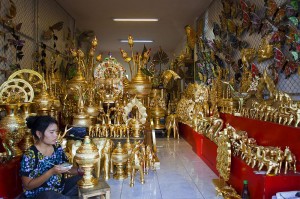 Baan Tawai is the village of wood-carving handicrafts. It has long been known as the major cultural attraction of Chiang Mai for Thai and foreign tourists. The best quality and bargain wood carving items can be found in Baan Tawai. At present, a wide variety of wood carvings and other decorative items e.g. wood carving, wood-strips, gold leaf wood, wood-strips, gold leaf wood, antique wood, silverware, lacquer ware, hand-woven textile, basketry and earthenware, can be found in the Baan Tawai Handicraft Center and Baan Tawai Song Fang KlongCenter.At the end of January each year, Baan Tawai celebrates wood carving with a week-long fair.
Baan Tawai is the village of wood-carving handicrafts. It has long been known as the major cultural attraction of Chiang Mai for Thai and foreign tourists. The best quality and bargain wood carving items can be found in Baan Tawai. At present, a wide variety of wood carvings and other decorative items e.g. wood carving, wood-strips, gold leaf wood, wood-strips, gold leaf wood, antique wood, silverware, lacquer ware, hand-woven textile, basketry and earthenware, can be found in the Baan Tawai Handicraft Center and Baan Tawai Song Fang KlongCenter.At the end of January each year, Baan Tawai celebrates wood carving with a week-long fair.
9. Sankhampang Hot Springs
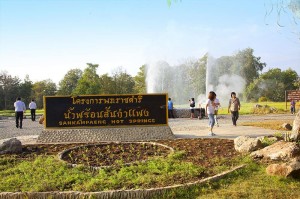 Located some 35km from Chiang Mai City, the Sankamphaeng Hot Springs may come as a surprise to those who don’t realise that Chiang Mai Province sits along a fortunately mostly inactive volcanic fault line. Located in a pretty landscaped park surrounded by agricultural land, the hot springs have been recently smartened up, but are not yet the equivalent of a western-style spa. The notice at the entrance stresses that the baths are intended for Thai families and advises westerners not to expect too much.
Located some 35km from Chiang Mai City, the Sankamphaeng Hot Springs may come as a surprise to those who don’t realise that Chiang Mai Province sits along a fortunately mostly inactive volcanic fault line. Located in a pretty landscaped park surrounded by agricultural land, the hot springs have been recently smartened up, but are not yet the equivalent of a western-style spa. The notice at the entrance stresses that the baths are intended for Thai families and advises westerners not to expect too much.
10. Chiang Mai Doi Inthanon Day Trip
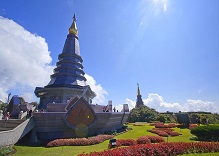 Chiang Mai is famous for its abundant natural beauty and when you visit the city’s surrounding regions, you will be overwhelmed. You simply cannot visit Chiang Mai without taking a trip out to Thailand’s largest mountain, Doi Inthanon, which is 2,565m (8,415 ft) above sea level. The journey from Chiang Mai City Center is roughly 60km southwest, which means it takes less than an hour to reach the front gates of Doi Inthanon National Park. The admission fee to Doi Inthanon National Park is 400baht for adults and 200baht for children.
Chiang Mai is famous for its abundant natural beauty and when you visit the city’s surrounding regions, you will be overwhelmed. You simply cannot visit Chiang Mai without taking a trip out to Thailand’s largest mountain, Doi Inthanon, which is 2,565m (8,415 ft) above sea level. The journey from Chiang Mai City Center is roughly 60km southwest, which means it takes less than an hour to reach the front gates of Doi Inthanon National Park. The admission fee to Doi Inthanon National Park is 400baht for adults and 200baht for children.
There are many things to see and do within the national park with 3 waterfalls, caves, hill-tribe village markets, temples, horticultural centers and last but not least, the summit of Doi Inthanon. The beauty is simply breathtaking.
11. Chiang Mai Monkey Centre
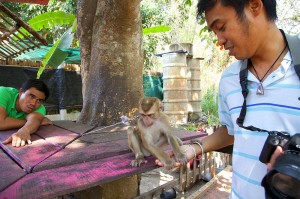 Every hour, you can enjoy monkey shows, which are a great experience where some audience-monkey interaction takes place. The monkeys display an amazing range of tricks that will keep you on the edge of your seats. See them playing basketball, bike-riding, coconut picking and calculating arithmetic. The main emphasis at the Chiang Mai Monkey Center is fun and a place to learn more about our intelligent cousins. All the monkeys at the center were not taken from the wild; they were either rescued or given to them from zoos that were overflowing with animals.
Every hour, you can enjoy monkey shows, which are a great experience where some audience-monkey interaction takes place. The monkeys display an amazing range of tricks that will keep you on the edge of your seats. See them playing basketball, bike-riding, coconut picking and calculating arithmetic. The main emphasis at the Chiang Mai Monkey Center is fun and a place to learn more about our intelligent cousins. All the monkeys at the center were not taken from the wild; they were either rescued or given to them from zoos that were overflowing with animals.
12. Chiang Mai Zoo
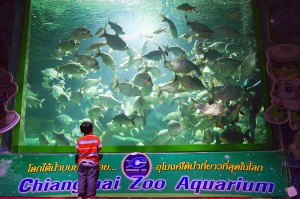 So many zoos in Thailand never live up to their expectations. Chiang Mai Zoo on the other hand is a completely different ballgame. First established in 1974, the zoo has become famous for being home to two pandas, ‘Chuang Chuang’ and ‘Lin Hui’, loaned from the Chinese government.
So many zoos in Thailand never live up to their expectations. Chiang Mai Zoo on the other hand is a completely different ballgame. First established in 1974, the zoo has become famous for being home to two pandas, ‘Chuang Chuang’ and ‘Lin Hui’, loaned from the Chinese government.
The two pandas became national and international news when they gave birth to a baby Giant Panda, named Lin Bing, which caused quite a lot of news activity across Thailand because of the surprise and the rareness of baby pandas. Although Chiang Mai Zoo has become famous for this reason, and you can also see the three Giant Pandas up close and personal for a 100 baht charge, the zoo is also one of Thailand’s finest.
13. Traditional Khantoke Dinner and Show
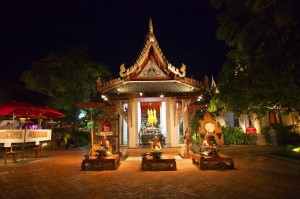 This traditional dinner and show became a social gathering in 1953, bonding together the best of the region’s cuisine, cultural and traditional dance shows. These elements complement each other in such a compulsive way that you must enjoy this experience when visiting Chiang Mai.
This traditional dinner and show became a social gathering in 1953, bonding together the best of the region’s cuisine, cultural and traditional dance shows. These elements complement each other in such a compulsive way that you must enjoy this experience when visiting Chiang Mai.
As a party of 5 friends, we were recommended to visit the Old Chiang Mai Cultural Center for the Khantoke Dinner and Show, which was one of our most memorable Chiang Mai experiences.
When first stepping foot in the venue, we were overwhelmed with the deep red carpets everywhere. The Khantoke Dinner is mainly a seat on the floor event, although the venue does also cater for those who want a standard table and chairs affair. We sat down crossed legged at our table to experience the meal as intended – on the floor.
14. Borsang Fishing Park Chiang Mai
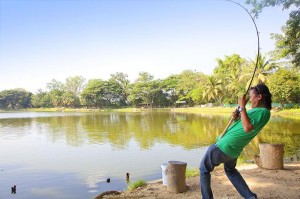 Situated within a short drive from the world-famous Borsang Umbrella Village, this fishing park is roughly a 30-minute drive from the heart of Chiang Mai City. If you have come to Chiang Mai without your fishing tackle, Borsang Fishing Park is perfect for you because you can rent reels, rods and bait onsite for just 200 baht, alongside the 100 baht entry fee to the park. The size of the lake is approximately 6 acres, and is home to famous Northern Thai fish such as the Mekong Giant Catfish and the Striped Catfish although you will also find some Chinese Carp. Some of the Catfish can be up to 50kg in weight although on average there are lots weighing in between 20-30kg. It is not unheard for keen anglers to catch 20 Catfish in a day, with an average size of around 15kg.
Situated within a short drive from the world-famous Borsang Umbrella Village, this fishing park is roughly a 30-minute drive from the heart of Chiang Mai City. If you have come to Chiang Mai without your fishing tackle, Borsang Fishing Park is perfect for you because you can rent reels, rods and bait onsite for just 200 baht, alongside the 100 baht entry fee to the park. The size of the lake is approximately 6 acres, and is home to famous Northern Thai fish such as the Mekong Giant Catfish and the Striped Catfish although you will also find some Chinese Carp. Some of the Catfish can be up to 50kg in weight although on average there are lots weighing in between 20-30kg. It is not unheard for keen anglers to catch 20 Catfish in a day, with an average size of around 15kg.
15. X-Center in Chiang Mai
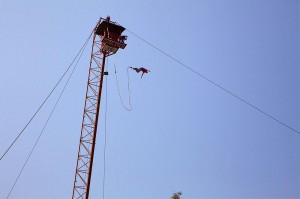 Adrenalin junkies visiting Chiang Mai should stop right in their tracks and listen up. The X-Center at Chiang Mai is one of those places that thrill seekers will fall in love with on their first impression. This one-stop-shop of adventure activities has everything all under one roof. Choose from an impressive selection of adventure activities at this purpose-built venue:
Adrenalin junkies visiting Chiang Mai should stop right in their tracks and listen up. The X-Center at Chiang Mai is one of those places that thrill seekers will fall in love with on their first impression. This one-stop-shop of adventure activities has everything all under one roof. Choose from an impressive selection of adventure activities at this purpose-built venue:
– Jungle Bungy Jump
– Xorb Ball
– Off Road Buggies
– Drift Go-Karts
– Trial Bikes
– Paint Ball
Situated on Mae Rim-Samoeng Road, under a 10-minute drive from Chiang Mai city center, the X-Center is located on your left hand side – you simply cannot miss it. When we arrived at the X-Center, we were immediately blown away by the set-up. You are first greeted by a large car park, restaurant and main office, behind which you will see a lake, bungy crane and a custom-built covered go-kart track. Everything gleams of newness.
16. Bo Sang Umbrella Village in Chiang Mai
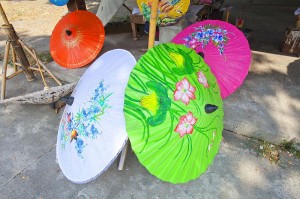 Chiang Mai is not only famous for its arts and crafts, but also for its unique items that cannot be purchased anywhere else. Chiang Mai’s umbrella production tradition goes back over 200 years. Bo Sang Umbrella Village in Chiang Mai reflects the true essence of this unique craft, using age-old methods to produce the most colourful and aesthetically pleasing umbrellas imaginable. The beautiful handcrafted parasols are made from silk, bamboo, rice and saa paper. Chiang Mai is actually home to an annual 3-day umbrella festival in the 3rd week of January. This colourful festival personifies Chiang Mai’s prestigious cultural reputation. It features exhibitions, contests, a Miss Bo Sang pageant, sizzling snacks, and, of course, a large number of umbrellas for sale. A colourful daytime umbrella procession and is followed by a night-time lantern procession. The festival is a highlight of the local calendar, with live northernThai music performed along Bo Sang’s main street.
Chiang Mai is not only famous for its arts and crafts, but also for its unique items that cannot be purchased anywhere else. Chiang Mai’s umbrella production tradition goes back over 200 years. Bo Sang Umbrella Village in Chiang Mai reflects the true essence of this unique craft, using age-old methods to produce the most colourful and aesthetically pleasing umbrellas imaginable. The beautiful handcrafted parasols are made from silk, bamboo, rice and saa paper. Chiang Mai is actually home to an annual 3-day umbrella festival in the 3rd week of January. This colourful festival personifies Chiang Mai’s prestigious cultural reputation. It features exhibitions, contests, a Miss Bo Sang pageant, sizzling snacks, and, of course, a large number of umbrellas for sale. A colourful daytime umbrella procession and is followed by a night-time lantern procession. The festival is a highlight of the local calendar, with live northernThai music performed along Bo Sang’s main street.
17. Mae Rim Hill Tribe Village in Chiang Mai
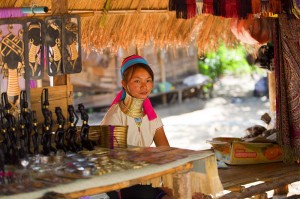 Thailand’s hill tribe villages have become one of the country’s leading tourist attractions spanning the northwest of Thailand in places such as Chiang Mai and Chiang Rai, which in comparison to beachside destinations such as Phuket and Koh Samui are a more authentic slice of real Thailand.
Thailand’s hill tribe villages have become one of the country’s leading tourist attractions spanning the northwest of Thailand in places such as Chiang Mai and Chiang Rai, which in comparison to beachside destinations such as Phuket and Koh Samui are a more authentic slice of real Thailand.
It’s easy for visitors to the Mae Rim Hilltribe Village in Chiang Mai to feel sorry for these people that live in the jungle, who have lived there for generations, but sometimes you have to wonder if their way of living is more in line with nature and polar opposites of our material trappings and consumerism mentality.
They all seemed extremely happy, classy and with a more humane attitude towards life than I could ever muster. The village is open to all for a 500 baht fee, giving you the opportunity to roam throughout the wooden hut village and observe the villagers going through their daily life routines, weaving fabrics and crafting handmade items for sale. Photo opportunities are aplenty, which really captures the atmosphere of this unique experience.

